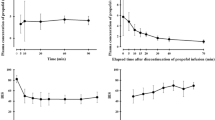Abstract
Conventional compartmental pharmacokinetic analysis may provide inaccurate prediction of drug concentrations after rapid iv administration. To examine this, compartment and effect compartment analysis was applied to measured arterial and brain concentrations of propofol in sheep after iv administration at a range of doses and dose rates. Although arterial and brain concentrations were reasonably well fitted to compartmental and effect compartment models for individual doses and dose rates, the structure and parameters of all models differed with changes in both dose and rate of administration. There were large discrepancies between predicted and measured arterial and brain concentrations when these models were used to predict drug concentrations across doses and dose rates. These data support the limitations of this type of modeling in the setting of rapid propofol administration.
Similar content being viewed by others
REFERENCES
I. Smith, P. F. White, M. Nathanson, and R. Gouldson. Propofol: an update on its clinical use. Anesthesiology 81:1005-1043 (1994).
J. Kanto and E. Gepts. Pharmacokinetic implications for the clinical use of propofol. Clin. Pharmacokin. 17:308-326 (1989).
J. Vuyk, F. H. M. Engbers, A. G. L. Burm, A. A. Vletter, and J. G. Bovill. Performance of computer-controlled infusion of propofol: An evaluation of five pharmacokinetic parameter sets. Anesth. Analg. 81:1275-1282 (1995).
W. L. Chiou. Potential pitfalls in the conventional pharmacokinetic studies. J. Pharmacokinet. Biopharm. 7:527-537 (1979).
T. C. Krejcie, T. K. Henthorn, C. A. Shanks, and M. J. Avram. A recirculatory pharmacokinetic model describing the circulatory mixing, tissue distribution, and elimination of antipyrine in dogs. J. Pharmacol. Exp. Ther. 269(2):609-616 (1994).
S. Bjorkman, J. Akeson, F. Nilsson, K. Messeter, and B. Roth. Ketamine and midazolam decrease cerebral blood flow and consequently their own rate of transport to the brain: an application of mass balance pharmacokinetics with a changing regional blood flow. J. Pharmacokin. Biopharm. 20:637-652 (1992).
G. L. Ludbrook, R. N. Upton, C. Grant, and E. C. Gray. The brain and blood concentrations of propofol after rapid iv injection in sheep, and their relationships to cerebral effects. Anaesth. Intensive Care 24(4):445-452 (1996).
G. L. Ludbrook, R. N. Upton, C. Grant, and A. Martinez. The effect of rate of administration on brain concentrations of propofol in sheep. Anesth. Analg. 00(6):1301-1306 (1998).
G. L. Ludbrook, R. N. Upton, C. Grant, and A. Martinez. Prolonged dysequilibrium between blood and brain concentrations of propofol during infusions in sheep. Acta Anaesthesiol. Scand. 43:206-211 (1999).
D. L. Roerig, K. J. Kotrly, C. A. Dawson, S. B. Ahlf, J. F. Gualtieri, and J. P. Kampine. First-pass uptake of verapamil, diazepam, and thiopental in the human lung. Anesth. Analg. 69:461-466 (1989).
T. K. Henthorn, T. C. Krejcie, and M. J. Avram. The relationship between alfentanil distribution kinetics and cardiac output. Clin. Pharmacol. Ther. 52:190-196 (1992).
D. Zheng, R. N. Upton, A. M. Martinez, C. Grant, and G. L. Ludbrook. The influence of the bolus injection rate of propofol on its cardiovascular effects and peak blood concentrations in sheep. Anesth. Analg. 86:1109-1115 (1998).
T. W. Schnider, C. F. Minto, P. L. Gambus, C. Andresen, D. B. Goodale, S. L. Shafer, and E. J. Youngs. The influence of method of administration and covariates on the pharmacokinetics of propofol in adult volunteers. Anesthesiology. 88:1170-1182 (1998).
H. K. Adam, L. P. Briggs, M. Bahar, E. J. Douglas, and J. W. Dundee. Pharmacokinetic evaluation of ICI 35 868 in man. Single induction doses with different rates of injection. Br. J. Anaesth. 55:97-103 (1983).
R. M. Tackley, G. T. Lewis, C. Prys Roberts, R. W. Boaden, J. Dixon, and J. T. Harvey. Computer controlled infusion of propofol. Br. J. Anaesth. 62:46-53 (1989).
R. N. Upton and G. L. Ludbrook. A physiological model of the induction of anaesthesia with propofol in sheep. 1. Structure and estimation of parameters. Br. J. Anaesth. 79:497-504 (1997).
Author information
Authors and Affiliations
Rights and permissions
About this article
Cite this article
Ludbrook, G.L., Upton, R.N., Grant, C. et al. A Compartmental Analysis of the Pharmacokinetics of Propofol in Sheep. J Pharmacokinet Pharmacodyn 27, 329–338 (1999). https://doi.org/10.1023/A:1020903315017
Published:
Issue Date:
DOI: https://doi.org/10.1023/A:1020903315017




